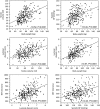Obesity and carotid artery remodeling
- PMID: 26302064
- PMCID: PMC4558557
- DOI: 10.1038/nutd.2015.26
Obesity and carotid artery remodeling
Abstract
Background/objective: The present study tested the hypothesis that obesity-related changes in carotid intima-media thickness (IMT) might represent not only preclinical atherosclerosis but an adaptive remodeling meant to preserve circumferential wall stress (CWS) in altered hemodynamic conditions characterized by body size-dependent increase in stroke volume (SV) and blood pressure (BP).
Subjects/methods: Common carotid artery (CCA) luminal diameter (LD), IMT and CWS were measured in three different populations in order to study: (A) cross-sectional associations between SV, BP, anthropometric parameters and CCA LD (266 healthy subjects with wide range of body weight (24-159 kg)); (B) longitudinal associations between CCA LD and 3-year IMT progression rate (ΔIMT; 571 healthy non-obese subjects without increased cardiovascular (CV) risk); (C) the impact of obesity on CCA geometry and CWS (88 obese subjects without CV complications and 88 non-obese subjects matched for gender and age).
Results: CCA LD was independently associated with SV that was determined by body size. In the longitudinal study, baseline LD was an independent determinant of ΔIMT, and ΔIMT of subjects in the highest LD quartile was significantly higher (28±3 μm) as compared with those in the lower quartiles (8±3, 16±4 and 16±3 μm, P=0.001, P<0.05 and P=0.01, respectively). In addition, CCA CWS decreased during the observational period in the highest LD quartile (from 54.2±8.6 to 51.6±7.4 kPa, P<0.0001). As compared with gender- and age-matched lean individuals, obese subjects had highly increased CCA LD and BP (P<0.0001 for both), but only slightly higher CWS (P=0.05) due to a significant increase in IMT (P=0.005 after adjustment for confounders).
Conclusions: Our findings suggest that in obese subjects, the CCA wall thickens to compensate the luminal enlargement caused by body size-induced increase in SV, and therefore, to normalize the wall stress. CCA diameter in obesity could represent an additional biomarker, depicting the impact of altered hemodynamics on arterial wall.
Figures


References
-
- Poirier P, Giles TD, Bray GA, Hong Y, Stern SJ, Pi-Sunyer X, et al. Obesity and cardiovascular disease: Pathophysiology, evaluation and effect of weight loss. An update of the 1997 American Heart Association Scientific Statement on Obesity and Heart Disease from the Obesity Committee of the Council on Nutrition, Physical Activity, and Metabolism. Circulation. 2006;113:898–918. - PubMed
-
- Bastien M, Poirier P, Lemieux I, Després JP. Overview of epidemiology and contribution of obesity to cardiovascular disease. Prog Cardiovasc Dis. 2014;56:369–381. - PubMed
-
- Kotsis VT, Stabouli SV, Papamichael CM, Zakopoulos NA. Impact of obesity in intima-media thickness of carotid arteries. Obesity. 2006;14:1708–1715. - PubMed
-
- Van Gaal LF, Mertens IL. Overweight, obesity, and blood pressure: the effects of modest weight reduction. Obesity. 2000;8:270–278. - PubMed
LinkOut - more resources
Full Text Sources
Other Literature Sources
Research Materials

